400 million bottles produced and easily sold, in 2020, for a turnover of 429 million euros abroad and 305 million euros in the Italian large-scale retail trade, with a growth on the markets of 4 %: these are the numbers of Italian sparkling wines, those under 2.5 atmospheres of pressures, capable of greater resilience than sparkling wines in the year of the pandemic, when, as reported in the “Sparkling wine Dossier” signed by “Corriere Vinicolo-Uiv”, they represented 9 % of shipments abroad in volume and 7 % in value. The first destination for Italian sparkling wines is still Germany, where 26 % of the bottles produced end up, followed by the USA (19%), Mexico (7%), Austria (4%), Russia (4%), Czech Republic (4%), UK (4%), France (4%), Holland (3%) and Spain (3%).
As far as production is concerned, 45% of production is represented by IGT wines, 37% by varietal and generic wines and 18% by DOP wines, and 90% of bottles come from just two regions: Emilia Romagna and Veneto. It is Lambrusco, as a denomination, to take the lion’s share, with 160 million bottles produced in 2020, of which 75% of Emilia IGT, which represents one bottle out of three (33%) of sparkling Igt and DOP wines, with Prosecco Doc in second place (21%, with 87 million bottles under 2.5 atmospheres out of a total of 501 million bottles produced in 2020). In terms of topology, reds and whites equally share the market, with a 45% share, whereas the remaining 10% is represented by rose wines, a higher percentage than sparkling wines (7%).
Another interesting fact, which emerges from the “Sparkling Dossier”, concerns the varieties used, that is any variety present in the Italian ampelographic panorama, from Pignoleto to Lambrusco, from Merlot to Sangiovese, from Chardonnay to Glera.
Copyright © 2000/2025
Contatti: info@winenews.it
Seguici anche su Twitter: @WineNewsIt
Seguici anche su Facebook: @winenewsit
Questo articolo è tratto dall'archivio di WineNews - Tutti i diritti riservati - Copyright © 2000/2025









































































































































































































